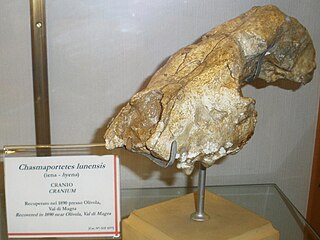
Hyenas, or hyaenas, are feliform carnivoran mammals of the family Hyaenidae. With only four extant species, it is the fifth-smallest biological family in the Carnivora and one of the smallest in the class Mammalia. Despite their low diversity, hyenas are unique and vital components of most African ecosystems.

Acinonyx is a genus within the cat family. The only living species of the genus, the cheetah, lives in open grasslands of Africa and Asia.

The order Peramelemorphia includes the bandicoots and bilbies; it equates approximately to the mainstream of marsupial omnivores. All members of the order are endemic to the twin land masses of Australia-New Guinea and most have the characteristic bandicoot shape: a plump, arch-backed body with a long, delicately tapering snout, very large upright ears, relatively long, thin legs, and a thin tail. Their size varies from about 140 grams up to 4 kilograms, but most species are about one kilogram, or the weight of a half-grown kitten.

Ceratotherium is a genus of the family Rhinocerotidae, consisting of a single extant species, the white rhinoceros, and its extinct relatives, Ceratotherium neumayri and Ceratotherium mauritanicum, of which Ceratotherium efficax is considered a synonym. Another species known as Ceratotherium praecox is now considered a member of the related Diceros.
Metailurini is an extinct taxonomic tribe of large saber-toothed cats that lived in Africa, Asia, Europe, and North America from the Miocene to the Pleistocene.

Aepyceros is a genus of African antelope that contains a single living species, the impala.
Australopithecus bahrelghazali is an extinct species of australopithecine discovered in 1995 at Koro Toro, Bahr el Gazel, Chad, existing around 3.5 million years ago in the Pliocene. It is the first and only australopithecine known from Central Africa, and demonstrates that this group was widely distributed across Africa as opposed to being restricted to East and southern Africa as previously thought. The validity of A. bahrelghazali has not been widely accepted, in favour of classifying the specimens as A. afarensis, a better known Pliocene australopithecine from East Africa, because of the anatomical similarity and the fact that A. bahrelghazali is known only from 3 partial jawbones and an isolated premolar. The specimens inhabited a lakeside grassland environment with sparse tree cover, possibly similar to the modern Okavango Delta, and similarly predominantly ate C4 savanna foods—such as grasses, sedges, storage organs, or rhizomes—and to a lesser degree also C3 forest foods—such as fruits, flowers, pods, or insects. However, the teeth seem ill-equipped to process C4 plants, so its true diet is unclear.

Chasmaporthetes, also known as hunting or running hyena, is an extinct genus of hyenas distributed in Eurasia, North America, and Africa during the Pliocene-Pleistocene epochs, living from 4.9 million to 780,000 years ago, existing for about 4.12 million years. The genus probably arose from Eurasian Miocene hyenas such as Thalassictis or Lycyaena, with C. borissiaki being the oldest known representative. The species C. ossifragus was the only hyena to cross the Bering land bridge into the Americas, and ranged over what is now Arizona and Mexico during Blancan and early Irvingtonian Land Mammal ages, between 5.0 and 1.5 million years ago.

Amphicyon is an extinct genus of large carnivorous bone-crushing mammals, popularly known as bear dogs, of the family Amphicyonidae, subfamily Amphicyoninae, from the Burdigalian Epoch until the late Pliocene, with the creature of bear-like and dog-like features. They ranged over North America, Europe, Asia, and Africa from 16.9 to 2.6 Ma ago, existing for approximately 14.3 million years.

Kolpochoerus is an extinct genus of the pig family Suidae related to the modern-day genera Hylochoerus and Potamochoerus. It is believed that most of them inhabited African forests, as opposed to the bushpig and red river hog that inhabit open brush and savannas. There are currently eight recognized species.
Gazella psolea is an unusual prehistoric species of gazelle that lived in Africa and Arabia; it is only known from fossils. It makes up the subgenus Deprezia due to its unique skull morphology: it had a long premolar row, and its nasal area is peculiar, with short nasal bones and a very large nasal opening. It therefore seems to have been able to breathe cold and dry air, but why this feature evolved is still rather mysterious. Perhaps it made seasonal migrations to the High Atlas mountains, where such an adaptation would have been useful.

Ontocetus is an extinct genus of walrus, an aquatic carnivoran of the family Odobenidae, endemic to coastal regions of the southern North Sea and the southeastern coastal regions of the U.S. during the Miocene-Pleistocene. It lived from 13.6 mya—300,000 years ago, existing for approximately 13.3 million years.

Pelagornis is a widespread genus of prehistoric pseudotooth birds. These were probably rather close relatives of either pelicans and storks, or of waterfowl, and are here placed in the order Odontopterygiformes to account for this uncertainty.
Ceratotherium mauritanicum is a species of fossil African rhinoceros found in the Late Pliocene to earliest Holocene of Morocco, Tunisia, and Algeria. Slightly older fossils from the Pliocene of eastern Africa were also proposed to belong to this species, but it has been considered to belong to a somewhat more primitive species, Ceratotherium efficax. A 2020 study considers C. efficax to be the same species as C. mauritanicum, however.

The greater Turkana Basin in East Africa determines a large endorheic basin, a drainage basin with no outflow centered around the north-southwards directed Gregory Rift system in Kenya and southern Ethiopia. The deepest point of the basin is the endorheic Lake Turkana, a brackish soda lake with a very high ecological productivity in the Gregory Rift.
Aepyceros datoadeni is an extinct impala which lived in what is now Ethiopia during the Pliocene epoch around 3 million years ago. It was described by Denis Geraads, René Bobe and Kaye Reed in 2012. In most respects, including the shape of the horns and teeth, it very closely resembled the living impala, although it was significantly smaller.
Damalborea is an extinct genus of alcelaphine bovid. It was first named by Alan W. Gentry in 2010, and the type species is Damalborea elisabethae. It is known from the holotype AL 208–7, a skull with horn cores collected from the Middle Pliocene Hadar Formation Member SH-3 of Ethiopia. In addition, a fossils of this or a closely related species were collected from Aramis, Wee-ee and Maka localities in the Middle Awash deposits, lower and upper units of the Laetolil Beds, as well as Tulu Bor Member and an unknown horizon of the Koobi Fora Formation. Geraads, Bobe & Reed (2012) assigned all Damalborea specimens from the Basal Member and Sidi Hakoma member of the Hadar Formation to the species D. elisabethae; in addition, the authors named the second species, Damalborea grayi, described on the basis of fossils from the Denen Dora member of the Hadar Formation. Damalborea was a moderately large alcelaphine with high and narrow skull proportions.
Enhydriodon dikikae is an extinct species in the family Mustelidae that existed during the Miocene and Pliocene epoch. Fossils from this species were discovered in Dikika, Lower Awash Valley in Ethiopia. These fossils were found in the lower basal member of the Hadar Formation, which means they existed more than 3.42 million years ago but the estimated age of the fossils is greater than 3.4 million years old and likely to be closer to 4 million years old. In comparison to the other species in the genus Enhydriodon, E. dikikae is one of the youngest.
Saïda Hossini is a Moroccan palaeontologist, specialising in frogs of the Pleistocene.

Dolichopithecus is an extinct genus of Old World monkey that lived in Europe during the Late Miocene and Pliocene.













